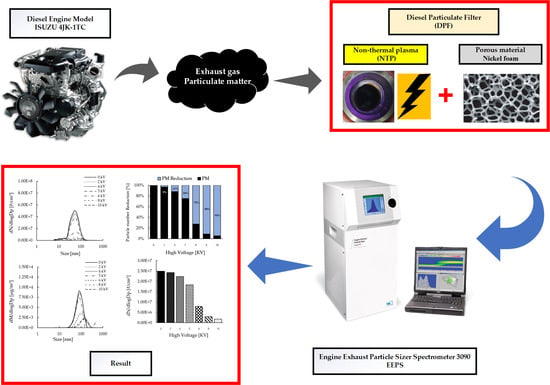The Influence of Nonthermal Plasma Technology on Oxidation Characteristics of Soot Operated on Direct Injection Internal Combustion Engines
Abstract
1. Introduction
2. Materials and Methods
2.1. Exhaust Particle Size
2.2. Nonthermal Plasma Reactor
2.3. Mechanism of NTP Technology on Particulate Matter (PM)
3. Result and Discussion
3.1. Effect of Non-Thermal Plasma (NTP) without Porous Material (0 mm)
3.2. Effect of Porous Material without Non-Thermal Plasma (NTP)
3.3. Effect of Porous Material with Non-Thermal Plasma (NTP)
4. Conclusions
Author Contributions
Funding
Conflicts of Interest
References
- Prasad, R.; Singh, S.V. A review on catalytic oxidation of soot emitted from diesel fuelled engines. J. Environ. Chem. Eng. 2020, 8, 103945. [Google Scholar] [CrossRef]
- Feng, X.; Ge, Y.; Ma, C.; Tan, J.; Yu, L.; Li, J.; Wang, X. Experimental study on the nitrogen dioxide and particulate matter emissions from diesel engine retrofitted with particulate oxidation catalyst. Sci. Total Environ. 2014, 472, 56–62. [Google Scholar] [CrossRef] [PubMed]
- Reşitoğlu, İ.A.; Altinişik, K.; Keskin, A. The pollutant emissions from diesel-engine vehicles and exhaust aftertreatment systems. Clean Technol. Environ. Policy 2015, 17, 15–27. [Google Scholar] [CrossRef]
- Ou, J.; Meng, Z.; Hu, Y.; Du, Y. Experimental investigation on the variation characteristics of soot layer thickness and pressure drop during DPF/CDPF active regeneration. Chem. Eng. Sci. 2021, 241, 116682. [Google Scholar] [CrossRef]
- Mishra, A.; Prasad, R. Preparation and application of perovskite catalysts for diesel soot emissions control: An overview. Catal. Rev. Sci. Eng. 2014, 56, 57–81. [Google Scholar] [CrossRef]
- Zhu, X.; Wu, H.; Luo, J.; Liu, J.; Yan, J.; Zhou, Z.; Yang, Z.; Jiang, Y.; Chen, G.; Yang, G. Soot Oxidation in a Plasma-Catalytic Reactor: A Case Study of Zeolite-Supported Vanadium Catalysts. Catalysts 2022, 12, 677. [Google Scholar] [CrossRef]
- Dhal, G.C.; Mohan, D.; Prasad, R. Preparation and application of effective different catalysts for simultaneous control of diesel soot and NOX emissions: An overview. Catal. Sci. Technol. 2017, 7, 1803–1825. [Google Scholar] [CrossRef]
- Stępień, Z.; Ziemiański, L.; Żak, G.; Wojtasik, M.; Jęczmionek, Ł.; Burnus, Z. The evaluation of fuel borne catalyst (FBC’s) for DPF regeneration. Fuel 2015, 161, 278–286. [Google Scholar] [CrossRef]
- Pérez, V.R.; Bueno-López, A. Catalytic regeneration of Diesel Particulate Filters: Comparison of Pt and CePr active phases. Chem. Eng. J. 2015, 279, 79–85. [Google Scholar] [CrossRef]
- Murota, T.; Hasegawa, T.; Aozasa, S.; Matsui, H.; Motoyama, M. Production method of cerium oxide with high storage capacity of oxygen and its mechanism. J. Alloys Compd. 1993, 193, 298–299. [Google Scholar] [CrossRef]
- Mori, K.; Miyauchi, Y.; Kuwahara, Y.; Yamashita, H. Shape effect of MnOx-decorated CeO2 Catalyst in the Diesel Soot Oxidation. Bull. Chem. Soc. Jpn. 2017, 90, 556–564. [Google Scholar] [CrossRef]
- Liu, J.; Yang, J.; Sun, P.; Ji, Q.; Meng, J.; Wang, P. Experimental investigation of in-cylinder soot distribution and exhaust particle oxidation characteristics of a diesel engine with nano-CeO2 catalytic fuel. Energy 2018, 161, 17–27. [Google Scholar] [CrossRef]
- Gomez, E.; Rani, D.A.; Cheeseman, C.; Deegan, D.; Wise, M.; Boccaccini, A. Thermal plasma technology for the treatment of wastes: A critical review. J. Hazard. Mater. 2009, 161, 614–626. [Google Scholar] [CrossRef]
- Song, C.-L.; Bin, F.; Tao, Z.-M.; Li, F.-C.; Huang, Q.-F. Simultaneous removals of NOx, HC and PM from diesel exhaust emissions by dielectric barrier discharges. J. Hazard. Mater. 2009, 166, 523–530. [Google Scholar] [CrossRef]
- Shi, Y.; Cai, Y.; Li, X.; Ji, L.; Chen, Y.; Wang, W. Evolution of diesel particulate physicochemical properties using nonthermal plasma. Fuel 2019, 253, 1292–1299. [Google Scholar] [CrossRef]
- Babaie, M.; Kishi, T.; Arai, M.; Zama, Y.; Furuhata, T.; Ristovski, Z.; Rahimzadeh, H.; Brown, R.J. Influence of non-thermal plasma after-treatment technology on diesel engine particulate matter composition and NOx concentration. Int. J. Environ. Sci. Technol. 2015, 13, 221–230. [Google Scholar] [CrossRef]
- Fushimi, C.; Madokoro, K.; Yao, S.; Fujioka, Y.; Yamada, K. Influence of polarity and rise time of pulse voltage waveforms on diesel particulate matter removal using an uneven dielectric barrier discharge reactor. Plasma Chem. Plasma Process. 2008, 28, 511–522. [Google Scholar] [CrossRef]
- Vinh, T.Q.; Watanabe, S.; Furuhata, T.; Arai, M. Effects of particulate matter on NOx removal in dielectric barrier discharges. J. Energy Inst. 2012, 85, 163–169. [Google Scholar] [CrossRef]
- Kuwahara, T.; Yoshida, K.; Kuroki, T.; Hanamoto, K.; Sato, K.; Okubo, M. Pilot-Scale Combined Reduction of Accumulated Particulate Matter and NOx Using Nonthermal Plasma for Marine Diesel Engine. IEEE Trans. Ind. Appl. 2019, 56, 1804–1814. [Google Scholar] [CrossRef]
- Yao, S.; Kodama, S.; Yamamoto, S.; Fushimi, C.; Madokoro, K.; Mine, C.; Fujioka, Y. Characterization of an uneven DBD reactor for diesel PM removal. Asia-Pac. J. Chem. Eng. 2009, 5, 701–707. [Google Scholar] [CrossRef]
- Wang, P.; Gu, W.; Lei, L.; Cai, Y.; Li, Z. Micro-structural and components evolution mechanism of particular matter from diesel engines with non-thermal plasma technology. Appl. Therm. Eng. 2015, 91, 1–10. [Google Scholar] [CrossRef]
- Wang, P.; Cai, Y.X.; Zhang, L.; Tolksdorf, C. Physical and chemical characteristics of particulate matter from biodiesel exhaust emission using non-thermal plasma technology. Energy Fuels 2010, 24, 3195–3198. [Google Scholar] [CrossRef]
- Gao, J.; Ma, C.; Xing, S.; Sun, L.; Huang, L. Nanostructure analysis of particulate matter emitted from a diesel engine equipped with a NTP reactor. Fuel 2017, 192, 35–44. [Google Scholar] [CrossRef]
- Matti Maricq, M. Chemical characterization of particulate emissions from diesel engines: A review. J. Aerosol Sci. 2007, 38, 1079–1118. [Google Scholar] [CrossRef]
- Zhu, K.; Cai, Y.; Shi, Y.; Lu, Y.; Zhou, Y.; He, Y. The effect of nonthermal plasma on the oxidation and removal of particulate matter under different diesel engine loads. Plasma Process. Polym. 2021, 19, 2100104. [Google Scholar] [CrossRef]
- Vandenbroucke, A.M.; Morent, R.; de Geyter, N.; Leys, C. Non-thermal plasmas for non-catalytic and catalytic VOC abatement. J. Hazard. Mater. 2011, 195, 30–54. [Google Scholar] [CrossRef] [PubMed]
- Zheng, Q.; Zhao, Z.; Zuo, J.; Yang, J.; Wang, H.; Yu, S.; Yi, D. A comparative study: Early results and complications of percutaneous and surgical closure of ventricular septal defect. Cardiology 2009, 114, 238–243. [Google Scholar] [CrossRef] [PubMed]
- Magne, L.; Pasquiers, S. LIF spectroscopy applied to the study of non-thermal plasmas for atmospheric pollutant abatement. Comptes Rendus Phys. 2005, 6, 908–917. [Google Scholar] [CrossRef]
- Takaki, K.; Hatanaka, Y.; Arima, K.; Mukaigawa, S.; Fujiwara, T. Influence of electrode configuration on ozone synthesis and microdischarge property in dielectric barrier discharge reactor. Vacuum 2008, 83, 128–132. [Google Scholar] [CrossRef]
- Yang, S.; Aravind, I.; Zhang, B.; Weng, S.; Zhao, B.; Thomas, M.; Umstattd, R.; Singleton, D.; Sanders, J.; Cronin, S.B. Plasma-enhanced electrostatic precipitation of diesel exhaust using high voltage nanosecond pulse discharge. J. Environ. Chem. Eng. 2021, 9, 106565. [Google Scholar] [CrossRef]
- Choi, S.; Oh, K.-C.; Lee, C.-B. The effects of filter porosity and flow conditions on soot deposition/oxidation and pressure drop in particulate filters. Energy 2014, 77, 327–337. [Google Scholar] [CrossRef]
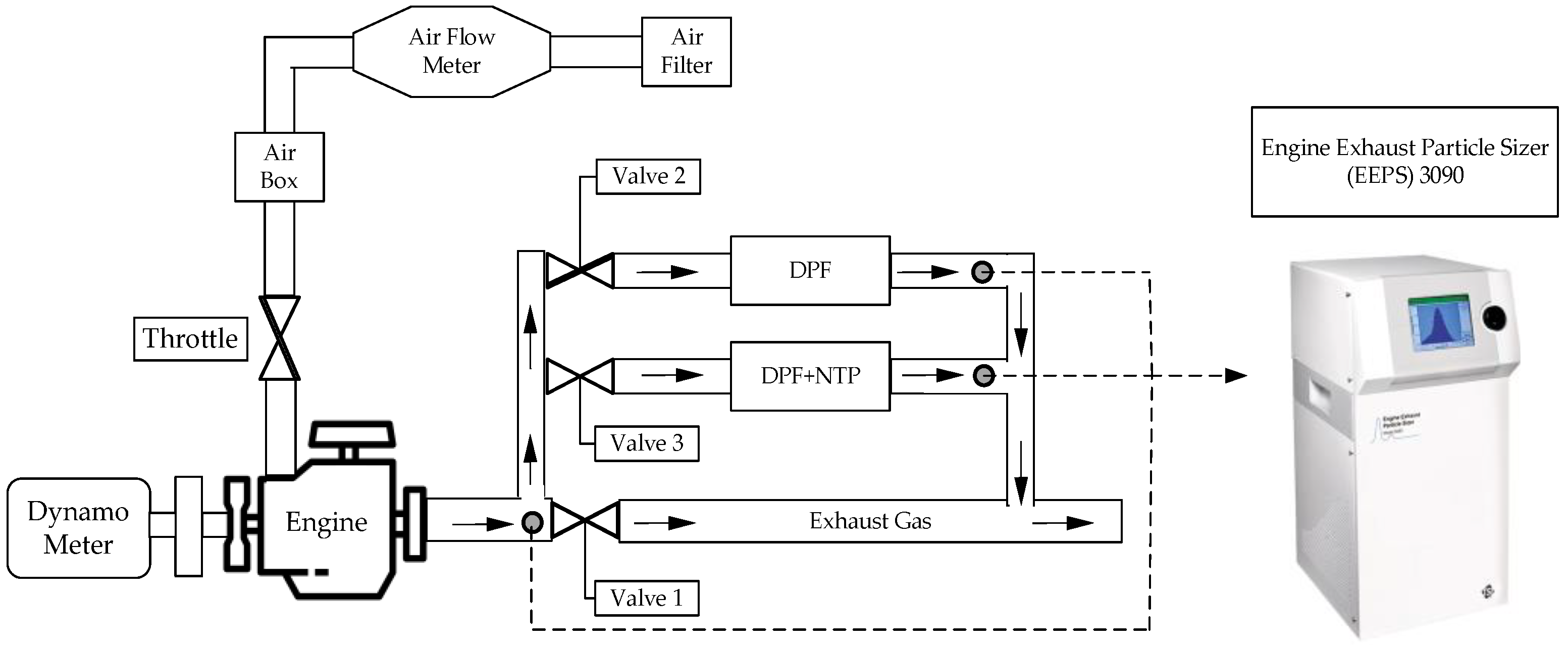

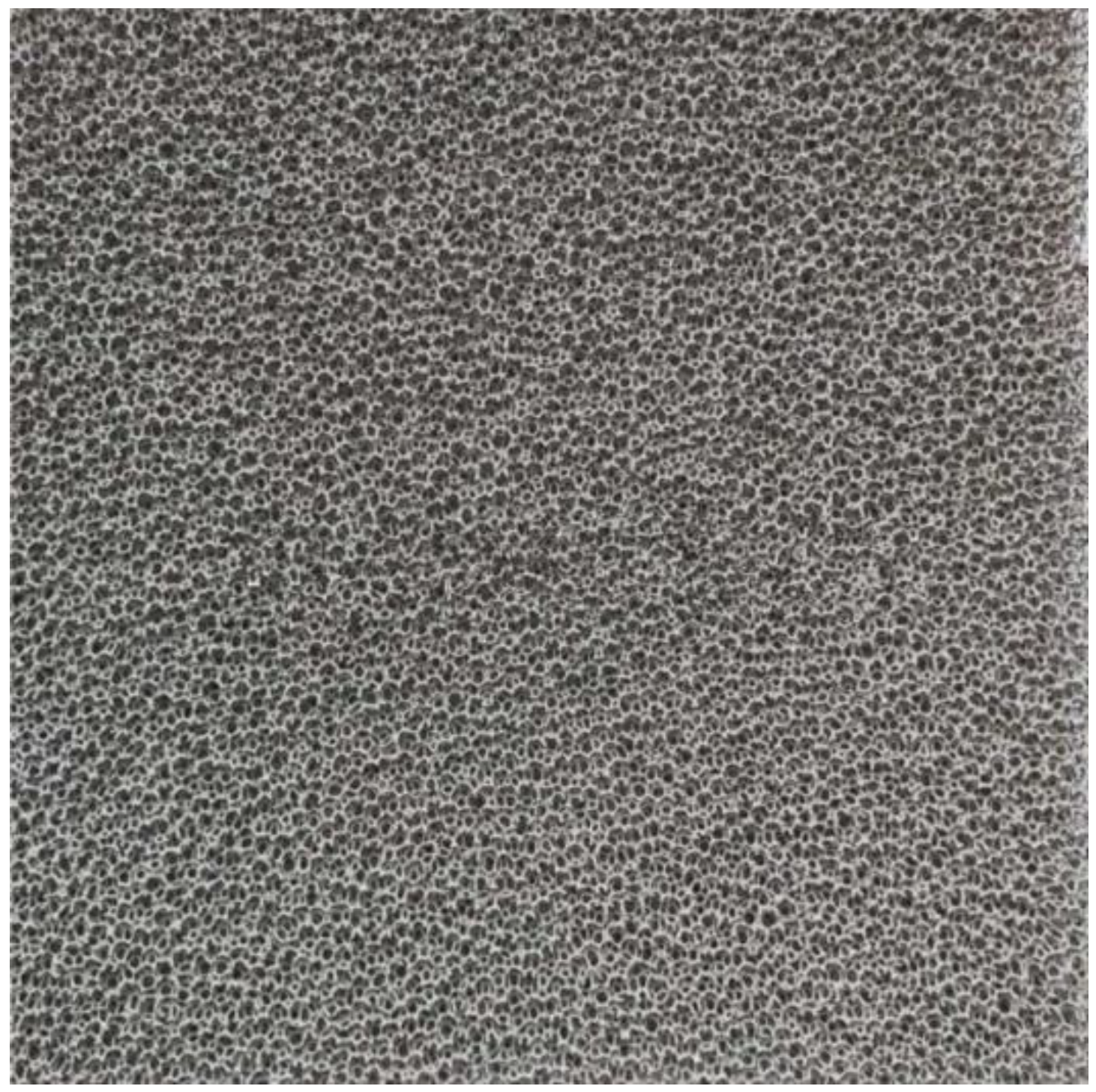
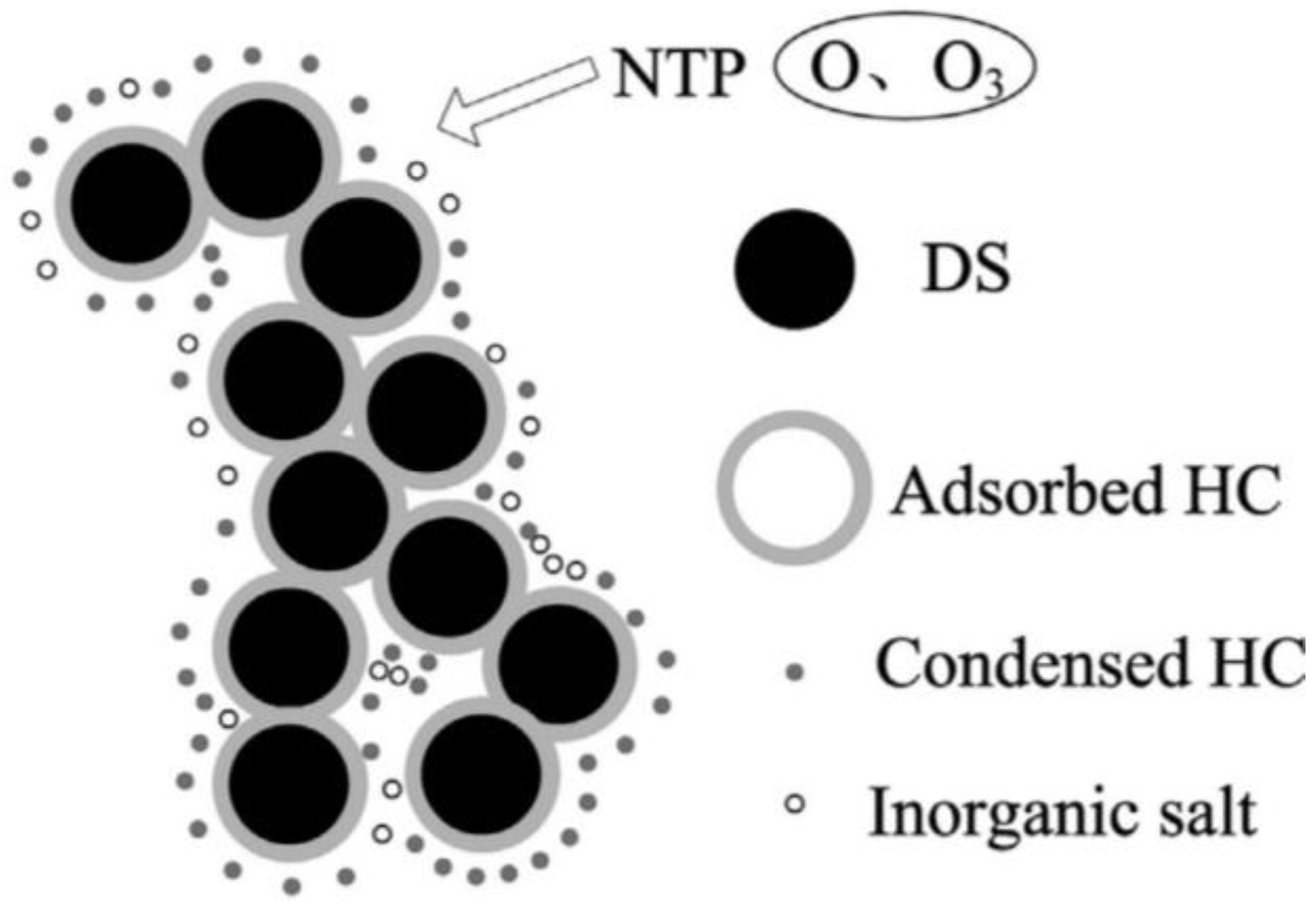
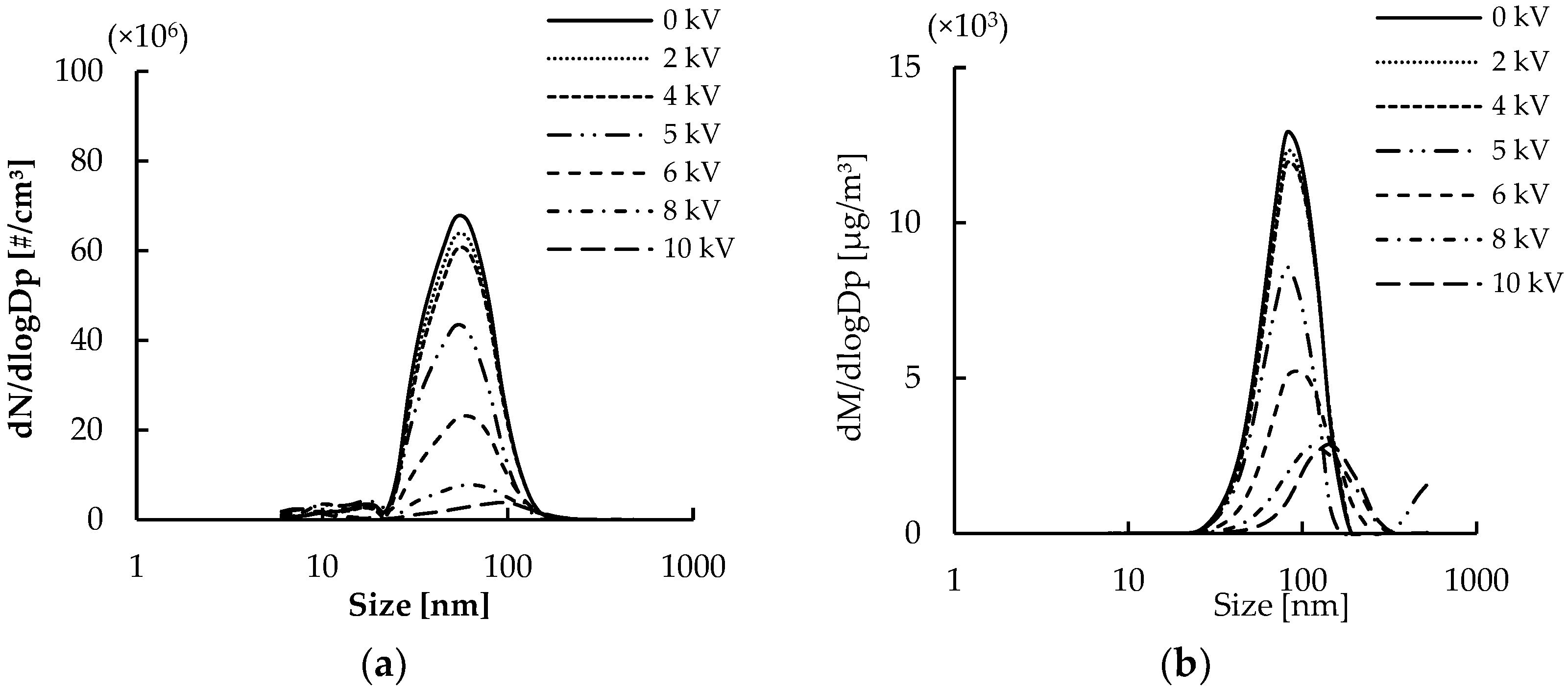
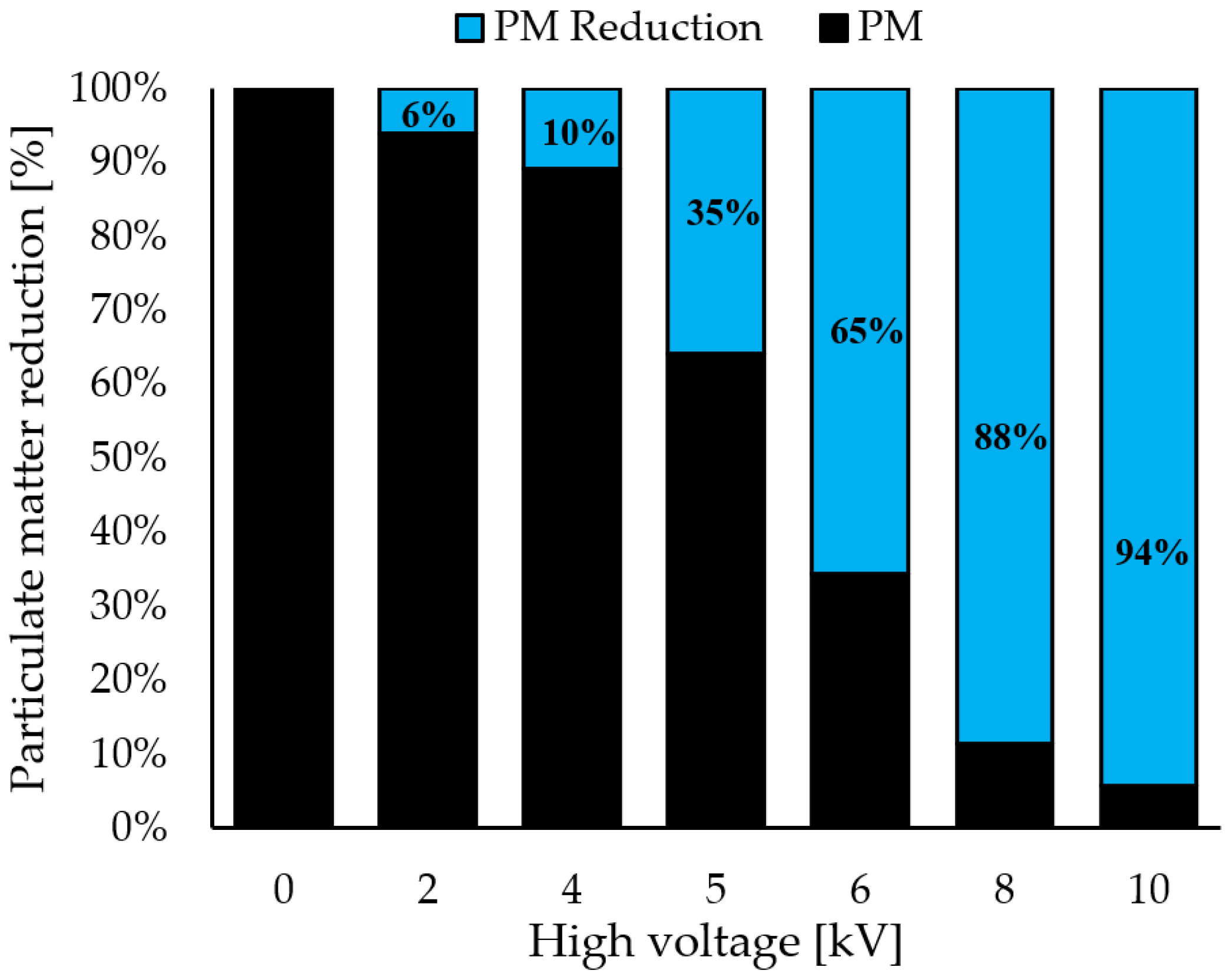
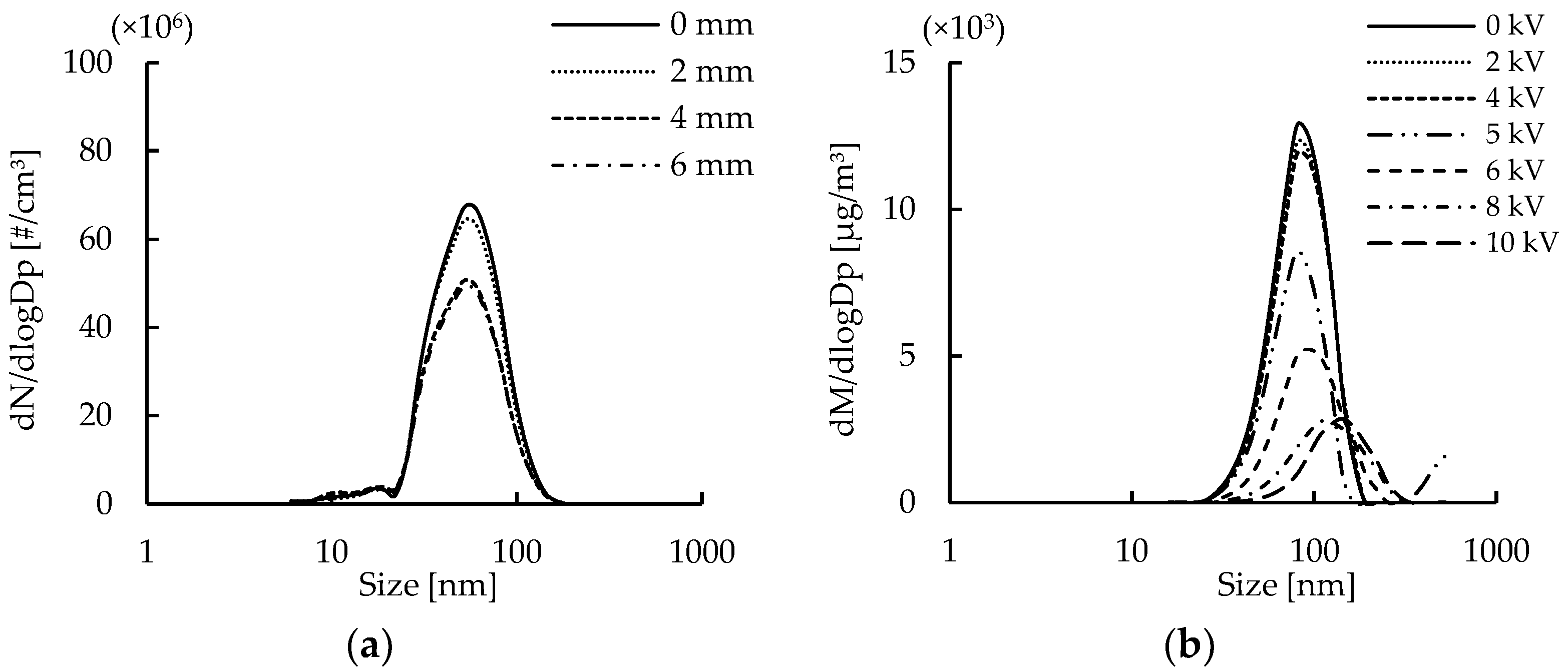

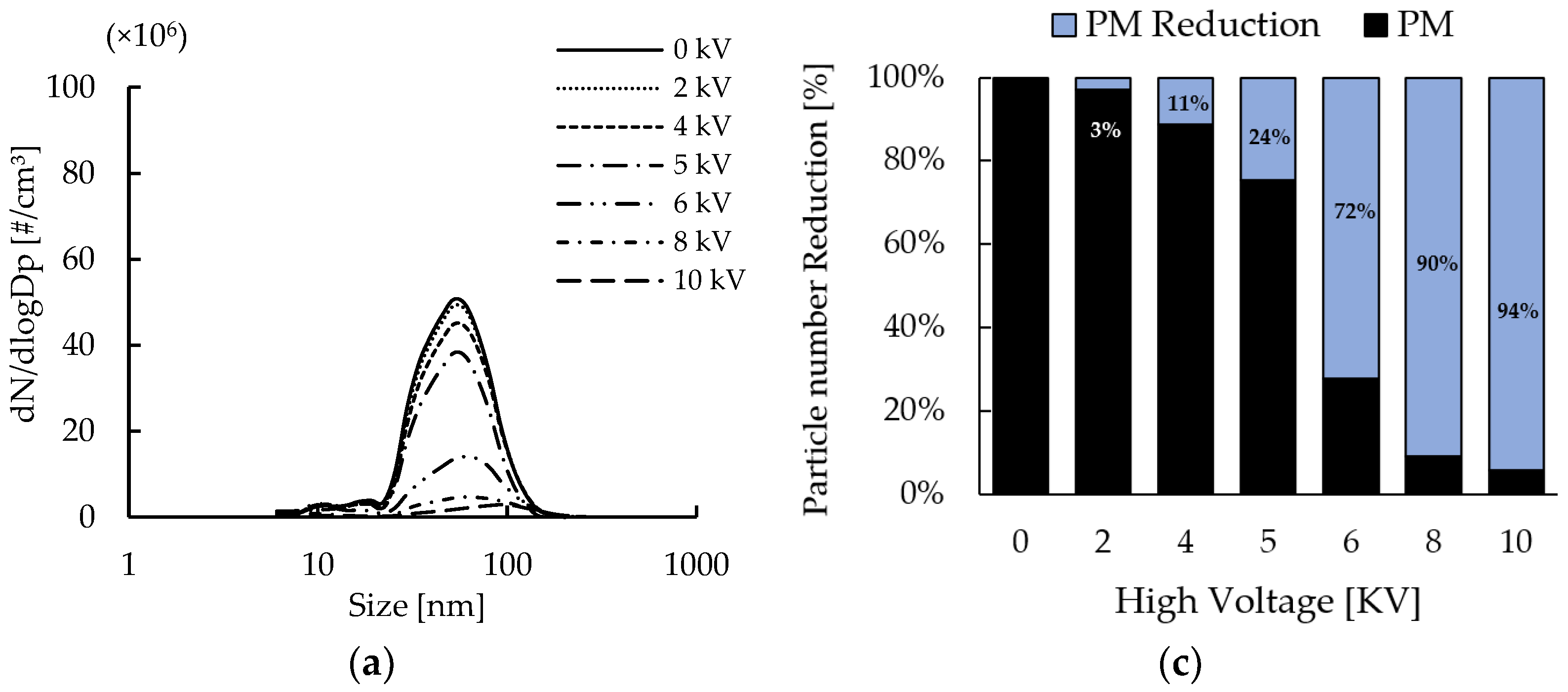
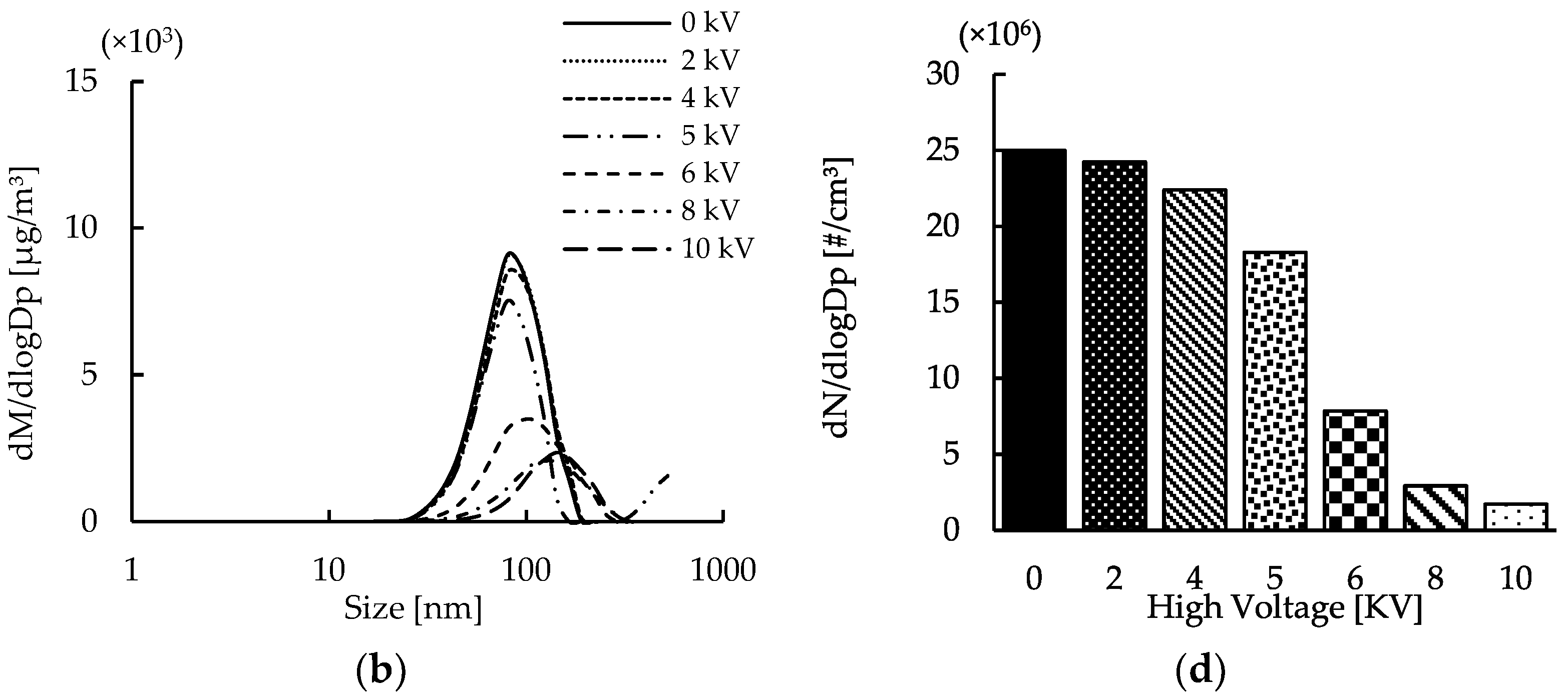

| Engine Parameter | Specifications |
|---|---|
| No of cylinder | 4 |
| Fuel injection | Common-rail DI |
| Displacement volume (cm3) | 2499 |
| Bore × Stroke (mm) | 95.4 × 87.4 |
| Compression ratio | 18.1 |
| Maximum power (kW) | 87@1800–2200 rpm |
| Maximum torque (Nm) | 280@1800–2200 rpm |
| Fuel | Biodiesel |
| Engine Parameter | Specifications |
|---|---|
| Material | Nickel foam |
| Number of holes (PPI) | 13–120 (±5 × 10) |
| Area density (g/m2) | 280 |
| Thickness (mm) | 2, 4, 6 |
| Diameter (mm) | 18 |
Publisher’s Note: MDPI stays neutral with regard to jurisdictional claims in published maps and institutional affiliations. |
© 2022 by the authors. Licensee MDPI, Basel, Switzerland. This article is an open access article distributed under the terms and conditions of the Creative Commons Attribution (CC BY) license (https://creativecommons.org/licenses/by/4.0/).
Share and Cite
Neamyou, P.; Theinnoi, K.; Sawatmongkhon, B.; Wongchang, T.; Wongkhorsub, C.; Sittichompoo, S.; Chuepeng, S. The Influence of Nonthermal Plasma Technology on Oxidation Characteristics of Soot Operated on Direct Injection Internal Combustion Engines. Energies 2022, 15, 9009. https://doi.org/10.3390/en15239009
Neamyou P, Theinnoi K, Sawatmongkhon B, Wongchang T, Wongkhorsub C, Sittichompoo S, Chuepeng S. The Influence of Nonthermal Plasma Technology on Oxidation Characteristics of Soot Operated on Direct Injection Internal Combustion Engines. Energies. 2022; 15(23):9009. https://doi.org/10.3390/en15239009
Chicago/Turabian StyleNeamyou, Pichitpon, Kampanart Theinnoi, Boonlue Sawatmongkhon, Thawatchai Wongchang, Chonlakarn Wongkhorsub, Sak Sittichompoo, and Sathaporn Chuepeng. 2022. "The Influence of Nonthermal Plasma Technology on Oxidation Characteristics of Soot Operated on Direct Injection Internal Combustion Engines" Energies 15, no. 23: 9009. https://doi.org/10.3390/en15239009
APA StyleNeamyou, P., Theinnoi, K., Sawatmongkhon, B., Wongchang, T., Wongkhorsub, C., Sittichompoo, S., & Chuepeng, S. (2022). The Influence of Nonthermal Plasma Technology on Oxidation Characteristics of Soot Operated on Direct Injection Internal Combustion Engines. Energies, 15(23), 9009. https://doi.org/10.3390/en15239009







